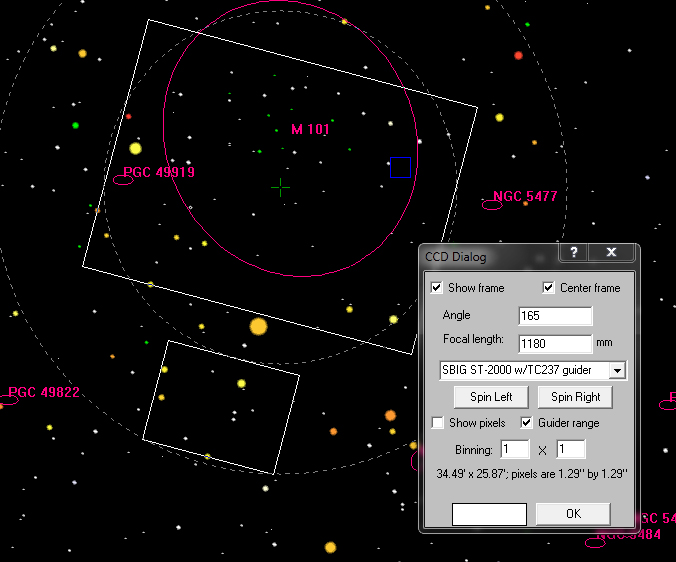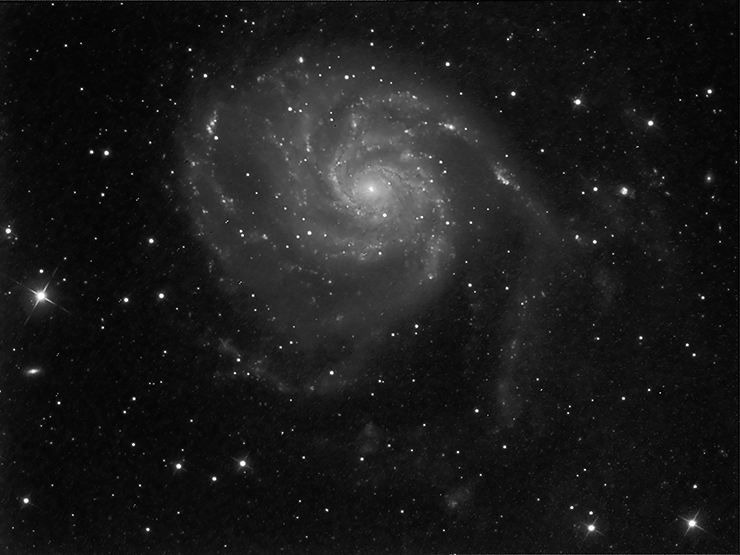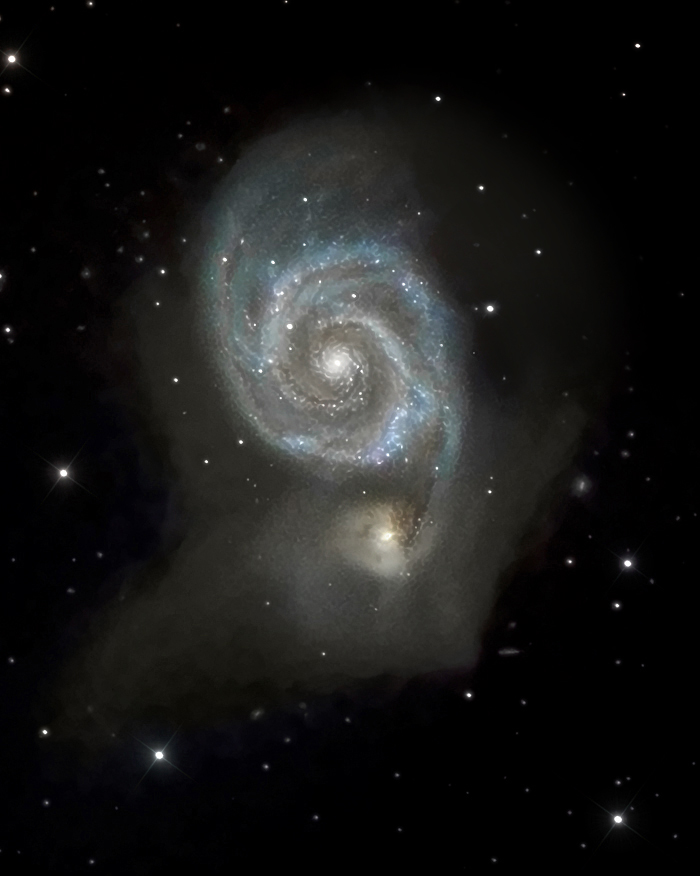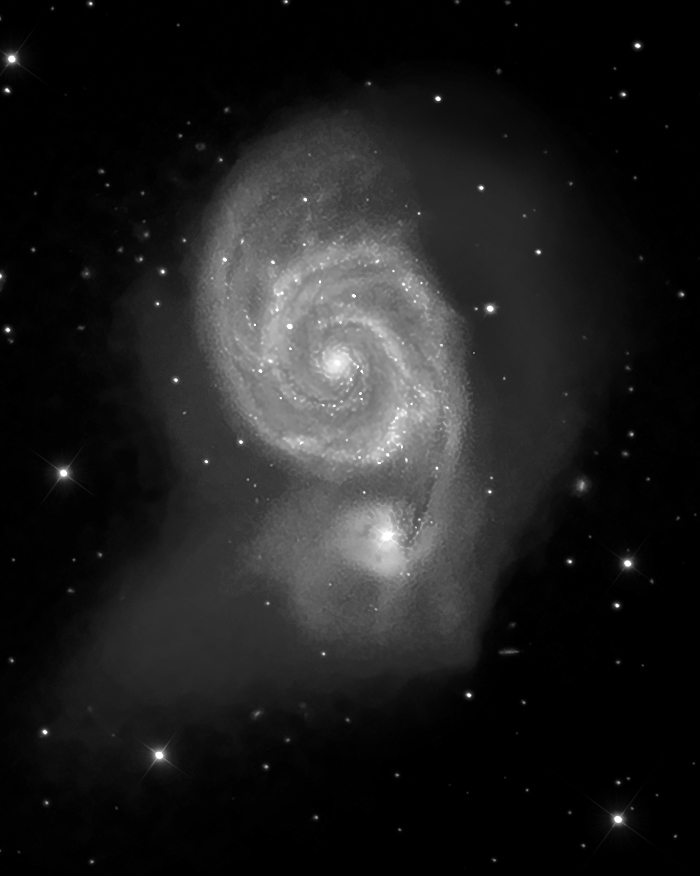06/11/2013. Sky trials for two new tools: the orientation scale and a workflow for closer-to-optimized exposures. I slewed to M101 and set the camera rotation to 165 degrees. Guide stars came up exactly as Guide 9.0 said they would. A ten second guide frame (captured during a hazy spell) is shown below the Guide chart of this evening's field:


The odd framing of M101 relative to its outline as drawn by Guide 9.0 is due to the outline not recognizing M101's extended spiral arm which I wanted to include in the photos. I measured average sky brightnesses in the 800-900 electron level with a 60s L-filter exposure. Then I made as many 150s subs as the night would hold. A brief cloudy spell prompted me to throw ~20 out. The 101 best subframes of M101 (!) look good:

M101
101x150s, L + 2x150s, RGB (4h 27m 30s)
AT10RC @ F4.8
150-second subframes produce very thin RGB data (as I should have anticipated since the average background is substantially reduced by the color filters). You might want to check the average RGB background counts and adjust the RGB exposures accordingly. I've reduced the histogram stretch of the L channel in the above image to insure that color data were available for all the prominent features. The luminance data can go considerably deeper, especially to the right of the main mass of the galaxy where puffs of stars appear well outside the spiral pattern:

M101
101x150s, L (4h 12m 30s)
A surprise: SN 2011FE is still visible in these images. It's down in the 19's. If memory and back of the envelope figures serve, that means it's about 5,000x fainter than at peak brightness. But there it is:

M101, SN 2011 FE indicated
101x150s, L (4h 12m 30s)
full size crop
There's a good bit more noise to control than I expected in these frames, and they're not really as sharp as I think they ought to be.
2013/06/12. If I spin the CCD to the 270° mark, Guide 9.0 says I'll find good guide stars for M51, everyone's favorite spiral galaxy. Just so! I wanted to catch the spray of stars around the two interacting galaxies, not only the prominent stream coming off at the 7 o'clock position but also the arc or shell to the right of the main spiral. This is hard to catch in L alone, but adding the color data brings the fainter shell out nicely. It's tempting to think that this is a collision between two galaxies comprised of different populations of stars, but I think it's more likely that the different colors (yellow in the shell and the smaller galaxy, blue in the spiral arms of the bigger one) came about as a result of the interaction. Density waves produced in the bigger galaxy become the sites of star formation; the smaller galaxy is just too small (and too disrupted) to support significant density waves. Something like that seems to be the received wisdom about these things:
 |
 |
M51
48x150s L, 2x300s RGB
(total 2h 30m)
They're shown at reduced scale because the tone transitions down in the "shadows" are
so harsh. Feel free to "view image" to see them bigger, but the results won't be pretty.
That's through hazy skies, again, and it's only 2 hours of luminance in 2.5 minute sips and half an hour of color in 5 minute gulps. Very promising, this matching of sub-exposures to sky brightness. I spent a lot longer processing this one than gathering the data. It's damned hard to keep the color from blotching when the RGB data has to be stretched so far. And I'm still seeing more noise than I expect from such a generous stack of L-filtered images (but a big pile of dark frames helped). The faint outer halo is too harshly rendered here. That, too, is caused by dredging faint data up from way down in the shadows. Those tones are represented by very few brightness levels and they fare badly when pushed up to visibility. More exposure, as usual, is the answer. The sky clouded over about 2:00AM and I had the telescope work on my dark library until dawn. The chip was warm: -15°C. I collected 24, 150-second darks and 32, 300-second darks at that balmy temperature. If it's gonna be that kind of summer, I might as well be ready to work with a warm chip. I could get out the water cooling apparati, but I have enough paraphrenalia paraphernalia littering the area around the telescope already.
06/14/2013. On this much cooler and substantially clearer night, I revisitted M51 with the chip at -25°C. Lacking a dark library for 150-second exposures at that temperature, I captured four darks and 36 bias frames with the idea that I would use the scant darks if needed but that I would count on the bias frames to allow Maxim to auto-scale or auto-optimize similar (but not identical) darks already in the tank. (Auto-scaling refers to using darks of the right temperature but different duration compared to the light frames being calibrated; auto-optimizing refers to iteratively auto-scaling darks of the same duration but made at different temperatures.) Works well. The darks used here were 150s but were captured at -20°C, five degrees warmer than the chip:

M51
54x150s L, 3s300s RGB
(2h15m L, 45m total RGB)
So I didn't get much of that arc of stars to the right. The flat may not be as good as I needed. But didn't the details in the galaxy come up nicely? The previous examples were processed mostly with Photoshop and FocusMax; the interesting bits for this one were done in PixInsight (color combine in Maxim, just routine image prep in Photoshop). Told you PixInsight was a nice package.
After M51 dropped near the treeline, I reset the telescope to galaxy cluster Abell 2151 in Hercules. There's a bright guide-star available at orientation 115°, but I opted to leave the camera oriented at 270° to avoid reshooting flats. There's a dimmer guide star available in that orientation (10.9 magnitude rather than 6.7), and it should do. I tripled the guide camera integratons to 30 seconds in deference to the fainter guidestar (overkill for L, thought I might need the exposure for RGB). The longer guide interval made very little difference to the size of the corrections the mount required (this is why we buy the good stuff). After making sure the guiding looked good and tweaking the focus a bit (10 Robofocus units in), I called it a night and left the telescope to do its work. And you know what? Abell 2151 hit the trees long before I had enough light collected. You can see a lot of galaxies in the field. They're there, but nobody's going to say, Wow. Let's save the bandwidth and not do the show part of show and tell until I've got more.
Except where noted, deep-sky photos are made with an SBIG ST2000XM CCD behind a 10-inch Astro-Tech Ritchey-Chretien carried on an Astro-Physics Mach1GTO. The CCD is equipped with Baader LRGB and 7nm H-a filters. The internal guide chip of the CCD most often keeps the OTA pointed in the right direction (I'll let you know when a Meade DSI and a separate OAG or guidescope takes its place). Camera control and guiding are handled by Maxim DL 5.12. The stock focuser on the AT10RC has been augmented with Robofocus 3.0.9 using adapters turned on the lathe downstairs. Maxim performs image calibration, alignment, and stacking; Photoshop CS4 and FocusMagic 3.0.2 take it from there. Gradient Xterminator by Russell Croman and Astronomy Tools by Noel Carboni see their share of work, too. Beginning in May 2013, PixInsight has taken over some of the heavy lifting for transfer function modification and deconvolution.
:: top ::